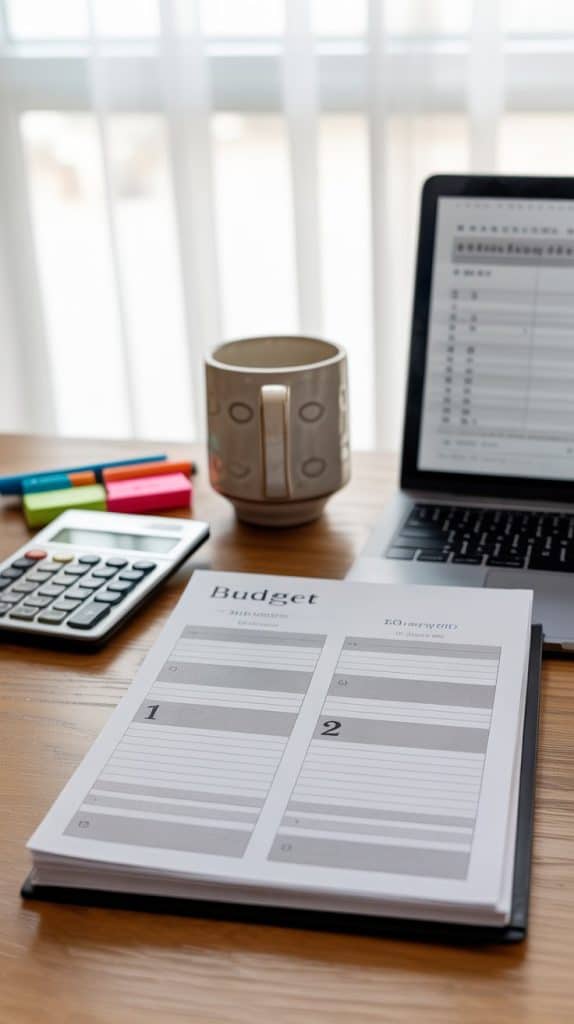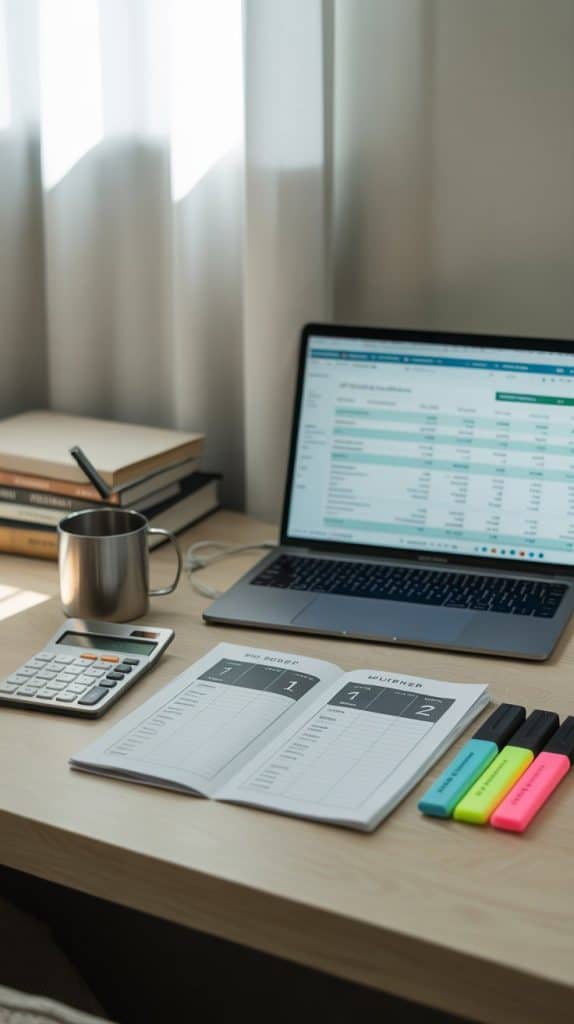What is the half payment budget method? Years ago when I was first starting my entrepreneurial journey, I wasn’t a big fan of budgeting because it felt very limiting to my already limited budget.
It felt like every deposit disappeared before I could catch my breath. Rent, bills, groceries, debt—gone. I wasn’t terrible with money, but I definitely wasn’t making it work for me either.
Then I came across the Half Payment Budget Method – this helped me finally get ahead, not just stay afloat.
If you’ve ever felt like you’re playing catch-up with your finances, or if your bank balance dips to scary-low levels before payday, this method might be the budgeting strategy you didn’t know you needed.
Let’s break it down step by step so you can make it work for your own situation.
Table of Contents
What Is the Half-Payment Budget Method?
The Half Payment Budget Method is a strategy where you split your large monthly bills (like rent, mortgage, utilities, etc.) into two smaller payments, timed with your paychecks.
Instead of paying a $1,200 rent bill all at once, you set aside $600 from each paycheck. This gives you breathing room, reduces financial stress, and helps you stay ahead of your bills.
It’s simple in theory but very helpful once implemented.
Why It Works:
- Prevents large bills from draining a single paycheck
- Builds consistency and predictability in your budget
- Makes it easier to save, plan, and handle surprise expenses

Who Is This Budgeting Method Best For?
If you live paycheck-to-paycheck, work with inconsistent income, or just feel like you’re always behind—this method is for you.
It’s especially helpful for:
- Biweekly or monthly pay schedules
- People with fixed monthly expenses
- Anyone trying to break out of the paycheck-to-paycheck cycle
The goal is to gain financial momentum by always being one step ahead, rather than scrambling to catch up.
Step-by-Step: How to Start Using the Half Payment Method
Here’s exactly how to start budgeting using the half-payment approach:
Step 1: List All Fixed Monthly Expenses
Start by writing down your non-negotiables—the things you must pay every month:
- Rent/Mortgage
- Utilities
- Car Payment
- Insurance
- Subscriptions (Netflix, Spotify, etc.)
- Childcare
Example:
- Rent: $1,200
- Electric: $150
- Car: $350
- Insurance: $100
- Subscriptions: $50
- Childcare: $1,000
- Total: $2,850
Step 2: Split Each Payment in Half
Now take each monthly bill and divide it by two. This shows what you’ll need to set aside from each paycheck.
Using the example above:
- Rent: $600
- Electric: $75
- Car: $175
- Insurance: $50
- Subscriptions: $25
- Childcare: $500
- Total per paycheck: $1,425
If you get paid twice a month, this becomes your core budget each time you get paid.
Step 3: Build a Paycheck Breakdown Template
Create a simple spreadsheet or use a budgeting app to track where every dollar goes from each paycheck.
Paycheck Example:
Monthly Income: $5,000
- Half-Pay Bills: $1,425
- Groceries: $300
- Gas: $100
- Savings: $250
- Buffer/Fun: $200
Total Expenses: $2,275
This gives every dollar a job, without overloading one paycheck.
Step 4: Get One Month Ahead (If You Can)
The real magic of the half-payment method kicks in when you’re one month ahead on bills. That way, you’re using this month’s income for next month’s expenses.
If you’re not there yet, no worries. Just work toward it slowly by saving small amounts each week or using tax refunds/bonuses.
Step 5: Track It Consistently
The key to staying on track is consistency. Whether you use:
- A paper planner
- Google Sheets
- An app
You need a system that shows you how much has already been set aside—and what’s still coming up.

Real Life Example: How I Used the Half-Payment Budget to Finally Breathe
Before I started this method, my rent crushed one paycheck entirely. That meant the next two weeks were tight – no room for savings, unexpected costs, or even an extra night out for dinner.
Once I started splitting my rent, car note, and insurance in half, I had enough left over from both paychecks to actually plan.
I added savings. A grocery plan. I even had more money freed up to pay down my credit card debt. None of that was possible before.
The best part? I stopped dreading payday. I already knew what was covered and where the money was going.

Tips to Make the Half-Payment Budget Method Work for You
1. Automate What You Can
Set up automatic transfers to savings or bill accounts so the money’s out of sight and protected from impulse spending.
2. Use Two Bank Accounts (Optional)
Some people like having one account for bills and one for spending. That way, they don’t accidentally dip into funds meant for rent or insurance. For me, this helped a big deal and simplified things in my mind.
3. Spread Out Due Dates When Possible
This is an often-overlooked strategy but can make a huge difference. If most of your bills are due in the first half of the month, one paycheck can end up completely wiped out.
By calling your service providers and shifting some due dates (subscriptions, utilities, car payments, credit cards, etc.), you can better distribute expenses across both paychecks and ease the pressure.
4. Plan for Irregular Expenses
This method works best when you also plan for things that aren’t monthly like annual fees, car tags, holidays, or birthdays. Build small sinking funds alongside your half-payments.
5. Adjust If You’re Paid Weekly
If you’re paid weekly, you can still use this method but just break large expenses into quarters instead of halves.

FAQs About the Half-Payment Budget Method
What if I can’t afford to split payments yet?
Start with just one bill. Focus on rent or your car payment. Build the habit slowly and expand as your income allows.
Should I open a separate account just for half-pay bills?
It’s not required, but it helps. Some people even name the account “Future Bills” to mentally keep it off-limits.
What happens if I forget to set aside a half payment?
That’s where tracking comes in. Use reminders, apps, or recurring calendar events so you don’t fall behind.
Final Thoughts: The Half Payment Method = Control
Budgeting doesn’t have to feel restrictive. As a matter of fact, the best budgeting system is the one that gives you freedom to plan, to save, and to breathe.
The Half Payment Budget Method isn’t magic. But it’s a simple, powerful shift in how you handle big bills. Instead of being blindsided every month, you’re ready.
So if you’ve been feeling stretched between paychecks or stuck in a constant cycle of stress, give this method a try.
Split it. Plan it. And watch what happens.
👉 Follow me on Pinterest for more tips on wealth, money and business!
Looking to Earn More? Learn More About Side Hustles
- How to Make Money on Upwork: My $100K+ Freelancer Story
- 5 Underrated Side Hustle Ideas that Make $8,000 a Month
- How to Start Freelancing with No Experience
- How to Make $1,000/Month Selling PDFs
- 5 Best Freelance Websites For Beginners
- How to Sell on Etsy as a Beginner and Make Your First Sale
My Favorite Tools
To help you reach your financial goals, below are resources you can use to get started. They are free to sign up and will support your money goals.


Leave a Reply